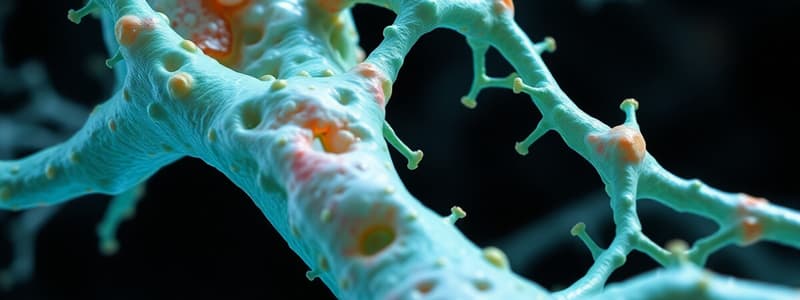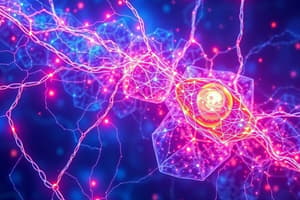Podcast
Questions and Answers
What distinguishes skeletal muscle fibers from cardiac muscle fibers on a microscopic level?
What distinguishes skeletal muscle fibers from cardiac muscle fibers on a microscopic level?
- Skeletal muscle fibers are non-striated, while cardiac muscle fibers are striated.
- Skeletal muscle fibers are fusiform, while cardiac muscle fibers are cylindrical.
- Skeletal muscle fibers are multinucleated, while cardiac muscle fibers have a single centrally located nucleus. (correct)
- Skeletal muscle fibers have intercalated discs, while cardiac muscle fibers do not.
Which structural feature is unique to smooth muscle compared to skeletal and cardiac muscle?
Which structural feature is unique to smooth muscle compared to skeletal and cardiac muscle?
- Intercalated discs
- Elongated fusiform shape (correct)
- Presence of striations
- Multinucleation
What connective tissue surrounds each individual skeletal muscle fiber?
What connective tissue surrounds each individual skeletal muscle fiber?
- Myofibril sheathing
- Epimysium
- Perimysium
- Endomysium (correct)
Which of the following statements about the sarcoplasmic reticulum of muscle cells is accurate?
Which of the following statements about the sarcoplasmic reticulum of muscle cells is accurate?
The presence of intercalated discs is a defining characteristic of which type of muscle tissue?
The presence of intercalated discs is a defining characteristic of which type of muscle tissue?
Which of the following statements about collagen fibers is true?
Which of the following statements about collagen fibers is true?
What is the primary function of the ground substance within the extracellular matrix?
What is the primary function of the ground substance within the extracellular matrix?
Which type of fibers is primarily made of elastin and provides elasticity?
Which type of fibers is primarily made of elastin and provides elasticity?
Reticular fibers are primarily composed of which type of collagen?
Reticular fibers are primarily composed of which type of collagen?
Which characteristic of connective tissue fibers contributes to its durability under shearing and tearing forces?
Which characteristic of connective tissue fibers contributes to its durability under shearing and tearing forces?
Which of the following connective tissue types is characterized by high vascularity and a rich nerve plexus?
Which of the following connective tissue types is characterized by high vascularity and a rich nerve plexus?
What role do glycosaminoglycans (GAG’s) play in the ground substance of connective tissue?
What role do glycosaminoglycans (GAG’s) play in the ground substance of connective tissue?
Which connective tissue component primarily binds and supports other tissues and organs?
Which connective tissue component primarily binds and supports other tissues and organs?
What is the primary role of fibroblasts in connective tissue?
What is the primary role of fibroblasts in connective tissue?
Which characteristic distinguishes active fibroblasts from inactive fibroblasts?
Which characteristic distinguishes active fibroblasts from inactive fibroblasts?
What type of cells are macrophages derived from?
What type of cells are macrophages derived from?
What is the function of mast cells in connective tissue?
What is the function of mast cells in connective tissue?
How are adipocytes primarily characterized in terms of their structure?
How are adipocytes primarily characterized in terms of their structure?
What mediates the physiological responses associated with mast cell activation?
What mediates the physiological responses associated with mast cell activation?
Which type of connective tissue cell is primarily responsible for phagocytosis?
Which type of connective tissue cell is primarily responsible for phagocytosis?
Which statement about macrophages is correct?
Which statement about macrophages is correct?
Which connective tissue cell type primarily contributes to the storage of fat?
Which connective tissue cell type primarily contributes to the storage of fat?
Which feature is commonly associated with mast cells in response to antigen exposure?
Which feature is commonly associated with mast cells in response to antigen exposure?
What type of connective tissue is characterized by densely packed parallel arrays of collagen fibers?
What type of connective tissue is characterized by densely packed parallel arrays of collagen fibers?
Which white blood cell type is primarily involved in allergic reactions and responses to parasitic infections?
Which white blood cell type is primarily involved in allergic reactions and responses to parasitic infections?
Which type of connective tissue is known for its abundant cells with scanty fibers and significant ground substance?
Which type of connective tissue is known for its abundant cells with scanty fibers and significant ground substance?
What is the role of heparin in the body?
What is the role of heparin in the body?
Which connective tissue type provides a network for the formation and repair of new tissue?
Which connective tissue type provides a network for the formation and repair of new tissue?
What distinguishes dense irregular connective tissue from dense regular connective tissue?
What distinguishes dense irregular connective tissue from dense regular connective tissue?
Which cell type is NOT considered a wandering cell in connective tissue?
Which cell type is NOT considered a wandering cell in connective tissue?
What type of epithelial tissue typically has a single layer of column-shaped cells that assist in absorption and secretion?
What type of epithelial tissue typically has a single layer of column-shaped cells that assist in absorption and secretion?
Which type of muscle tissue is characterized as being striated and under voluntary control?
Which type of muscle tissue is characterized as being striated and under voluntary control?
What microscopic feature primarily distinguishes epithelial tissues from connective tissues?
What microscopic feature primarily distinguishes epithelial tissues from connective tissues?
Which secretion method involves the release of secretory products by the disintegration of the entire cell?
Which secretion method involves the release of secretory products by the disintegration of the entire cell?
What type of exocrine gland is characterized by the formation of lipid droplets in the apical portion of the cell?
What type of exocrine gland is characterized by the formation of lipid droplets in the apical portion of the cell?
Which of the following is NOT a type of epithelial tissue?
Which of the following is NOT a type of epithelial tissue?
In exocrine glands, which type is responsible for the secretion of mucus?
In exocrine glands, which type is responsible for the secretion of mucus?
Which cell junction type provides the strongest adhesion between epithelial cells?
Which cell junction type provides the strongest adhesion between epithelial cells?
What is the primary function of tight junctions in epithelial tissues?
What is the primary function of tight junctions in epithelial tissues?
Which of the following is a characteristic feature of merocrine glands?
Which of the following is a characteristic feature of merocrine glands?
Which type of connective tissue is primarily responsible for storing fat?
Which type of connective tissue is primarily responsible for storing fat?
Which structure is a characteristic of multicellular exocrine glands?
Which structure is a characteristic of multicellular exocrine glands?
What histological feature distinguishes connective tissues from epithelial tissues?
What histological feature distinguishes connective tissues from epithelial tissues?
Flashcards are hidden until you start studying
Study Notes
Connective Tissue Overview
- Physically connects tissues and cells to form organs.
- Acts as binding material and offers metabolic support to cells.
- Highly vascular with rich nerve plexus and lymphatic vessels.
Components of Connective Tissue
- Extracellular Matrix (ECM): Consists of ground substance and fibers.
- Connective Tissue Cells: Include resident and wandering cells.
Extracellular Matrix (ECM)
- Ground Substance: Contains glycosaminoglycans (GAGs), proteoglycans, and glycoproteins.
- Ensures diffusion of small molecules, lubrication, and serves as a barrier to microorganisms.
- Fibers: Comprise collagen, elastic, and reticular fibers.
Connective Tissue Fibers
-
Collagen Fibers:
- Most abundant, providing tensile strength.
- Made of wavy collagen fibrils, synthesized by fibroblasts.
- Classified as Type I to XXV, found in ligaments, tendons, skin, bone.
-
Elastic Fibers:
- Thinner than collagen, allow for flexibility and recoil.
- Composed of elastin core and fibrillin microfibrils, found in aorta, skin, lungs.
-
Reticular Fibers:
- Type III collagen, forming a supportive net (reticulum).
- Found in liver, spleen, and bone marrow.
Types of Connective Tissue
- Embryonic Connective Tissue: Mesenchyme and mucoid.
- Connective Tissue Proper: Divides into loose and dense connective tissues.
- Specialized Connective Tissue: Includes bone, cartilage, blood, and lymphatics.
Loose Connective Tissue
- Composed of abundant cells and scant fibers.
- Surrounds glands and blood vessels, found beneath epithelia.
Dense Connective Tissue
-
Dense Regular:
- Densely packed collagen fibers with few cells.
- Found in tendons and ligaments.
-
Dense Irregular:
- Randomly arranged collagen fibers, protects organs.
- Found in dermis of skin and organ capsules.
Connective Tissue Cells
-
Resident Cells:
- Fibroblasts: Synthesize extracellular elements, have elongated nuclei.
- Adipocytes: Store fats and produce hormones.
- Mast Cells: Contain histamine and heparin, involved in inflammatory responses.
- Macrophages: Phagocytic, derived from monocytes, abundant in inflammation sites.
-
Wandering Cells: Include lymphocytes, neutrophils, eosinophils, basophils, monocytes, plasma cells.
Glandular Epithelium
- Types of glands:
- Endocrine Glands: Secrete hormones directly into the bloodstream.
- Exocrine Glands: Have ducts and include three secretion types:
- Merocrine: exocytosis of vesicles (e.g., saliva).
- Apocrine: cell cytoplasm and secretory products released (e.g., milk).
- Holocrine: disintegration of secretory cells (e.g., sebaceous glands).
Muscle Tissue
- Composed of cells specialized for contraction, facilitating body movement and organ function.
Types of Muscle Tissue
-
Skeletal Muscle:
- Multinucleated, striated fibers.
- Surrounded by epimysium, fascicles separated by perimysium.
- Each muscle fiber within fascicles is enveloped by endomysium.
-
Cardiac Muscle:
- Striated with centrally positioned nucleus, joined by intercalated discs.
-
Smooth Muscle:
- Elongated, fusiform cells lacking striations.
- Found in walls of hollow organs (e.g., intestines, blood vessels).
Summary
- Connective tissue plays essential roles in supporting organs and enabling functional connectivity within the body. Understanding its structure, types, and cellular components is crucial for comprehending overall body physiology.
Studying That Suits You
Use AI to generate personalized quizzes and flashcards to suit your learning preferences.




